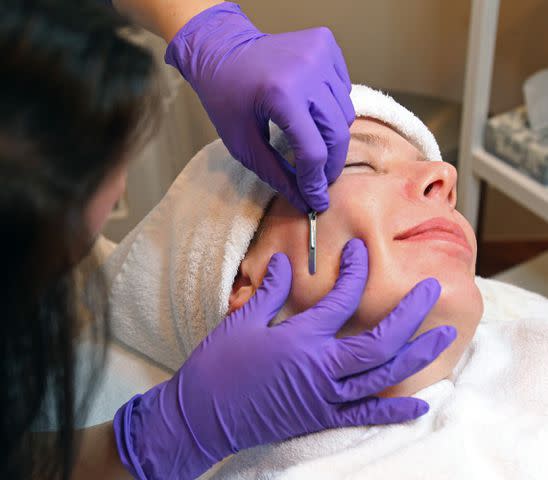Dermatologists Explain the Pros and Cons of Dermaplaning

Getty Images
Every time we shave, in addition to removing unwanted hair, we're removing some dead skin. That's the idea behind dermaplaning, a method of exfoliation. The in-office version involves to use of a surgical scalpel while the at-home version uses a single-blade razor to scrape away dullness. "Essentially, dermaplaning is shaving your skin with a razor or sharp blade, plus removal of a little more of the top layer of skin the stratum corneum," says board-certified dermatologist Anar Mikailov, MD. "It’s easy to do, there's not much downtime, and it's generally safe."
Ahead, you'll find everything you need to know about dermaplaning, including its benefits and drawbacks.
Meet Our Expert
Anar Mikailov, MD, is a board-certified dermatologist and the co-founder of Skintensive.
Ranella Hirsch, MD, is a board-certified dermatologist who is based in Boston.
Bertha Baum, DO, is a board-certified dermatologist at Aventura Dermatology.
Benefits of Dermaplaning

Getty Images
Removal of Unwanted Facial Hair
"Dermaplaning uses a blade to shave the vellus facial hair, that fine fuzz most visible on your lateral cheeks," says board-certified dermatologist Ranella Hirsch, MD. So it's great for anyone experiencing unwanted facial hair. Dr. Mikailov adds that "many women who have a higher density of facial hair really love this procedure."
Enhanced Product Absorption
Because hair and dead skin is removed during this dermaplaning, board-certified dermatologist Bertha Baum, DO, explains that it can enhance the effectiveness of skin-care products. "By eliminating the barrier of dead skin cells and peach fuzz, skin-care products can penetrate the skin more effectively, leading to better results from serums, moisturizers, and other skin-care treatments, contributing to a brighter and more radiant complexion," says Dr, Baum.
Tips
"Consider dermaplaning with a thicker cream that has coconut oil (Skintensive Daily Moisturizer or Cetaphil) instead of shaving cream—this will help prevent irritation," says Dr. Mikailov.
Smoother Skin
"Generally after this procedure, skin looks smoother without all of that hair/fuzz," says Dr. Mikailov. "Many women love how this procedure allows their makeup to look smooth."
Brighter Skin
"Dermaplaning can help brighten the skin because the procedure involves exfoliating the outermost layer of the skin, revealing fresher, healthier skin underneath and leading to a brighter complexion," says Dr. Baum. "The removal of dead skin cells through dermaplaning promotes skin cell turnover, which can improve the skin's texture and overall appearance."
Potential Wrinkle Prevention
"There is a hypothesis that dermaplaning or shaving regularly decreases wrinkling based on observations that areas on men's faces that are shaved daily have fewer wrinkles," says Dr. Mikailov.
Related: How to Curate an Anti-Aging Skincare Routine, According to Dermatologists
Instant Results
Unlike more intense services, you see the difference from dermaplaning as soon as it's over. "Instant results can be seen after a session," says Dr. Baum. "And, there is typically little-to-no downtime associated with dermaplaning, allowing patients to resume their regular activities immediately after the procedure."
Downsides of Dermaplaning

Getty Images
Irritation
"In a small percentage of users dermaplaning can trigger an irritation reaction, which leads to red stinging sensation of the face," says Dr. Mikailov. "An allergic reaction can happen if you are allergic to any of the creams or washes used to prep the skin.
Ingrown Hairs
If you're prone to getting ingrown hairs on your face, Dr. Baum says that as they hair grows back in after dermplaning, there is the potential for regrowth of ingrown hairs.
Related: Amazon Shoppers Call This Best-Selling Toner a “Miracle Must-Have” for Ingrown Hairs and Razor Bumps
Folliculitis
"I see a lot of acne-like bumps around hair follicles after dermaplaning," says Dr. Mikailov. These bumps are known as folliculitis and they're a common side effect of shaving. They're caused by an infection of the follicle.
Exacerbation of Skin Conditions
"Dermaplaning is not suitable for individuals with active acne or inflamed skin conditions, eczema, or psoriasis, as it can exacerbate these conditions," says Dr. Baum.
Frequently Asked Questions
Will dermaplaning cause hair to grow back thicker or darker?
"After dermaplaning, the fine vellus hair, commonly known as peach fuzz, will eventually grow back and typically feels the same as it did before the dermaplaning procedure," says Dr. Baum.
How does at-home dermaplaning differ from in-office dermaplaning?
"In office, the tools are generally a little stronger," says Dr. Mikailov. "Plus the procedure is much less effective when done by yourself. It is more precise and effective when done by a second person who is trained."
How often should you dermaplane?
If you're doing it at home, Dr. Mikailov says not to do it more than once or twice a week. If you're getting it done professionally, Dr. Baum says to go every three to four weeks.
For more InStyle news, make sure to sign up for our newsletter!
Read the original article on InStyle.

